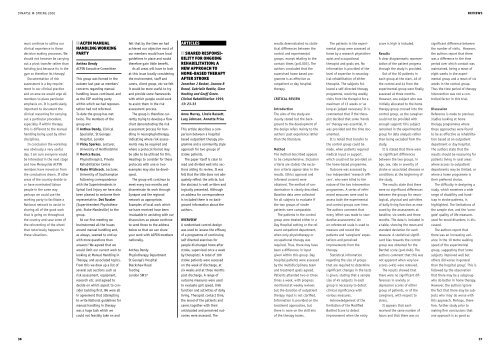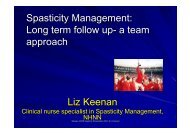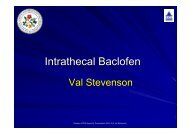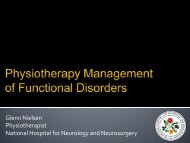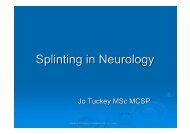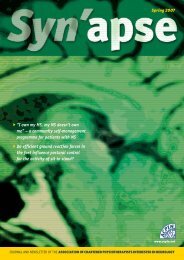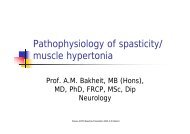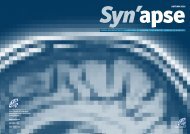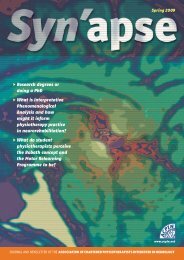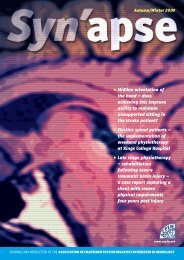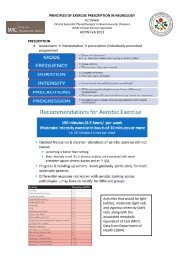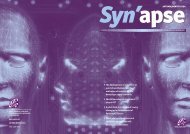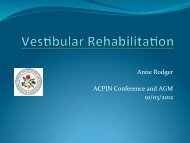SYNAPSE ● <strong>SPRING</strong> <strong>2000</strong>REVIEWSmust continue to utilise ourclinical experience in thesedecision making processes. Weshould not however be carryingout a pivot transfer rather thanhoisting just because its in thegym so therefore its therapy!Documentation of riskassessment is a key requirementin our clinical practiceand an area we would urge allmembers to place particularemphasis on. It is particularlyimportant to document theclinical reasoning for carryingout a particular procedure,especially if within therapythis is different to the manualhandling being used by otherdisciplines.In conclusion the workshopwas obviously a very usefulday. I am sure everyone wouldbe interested in the next stageand how Merseyside ACPINmembers have moved on fromthe conclusions drawn. If otherareas of the country decide toor have nominated liaisonpeople in the same wayperhaps we could use theworking party to facilitate aNational network to assist insharing all of the good workthat is going on throughoutthe country and save some ofthe reinventing of the wheelthat notoriously happens inthese situations.■C ACPIN MANUALHANDLING WORKINGPARTYAnthea DendyACPIN Executive CommitteeThis group was formed in theautumn last year as members’concerns regarding manualhandling issues continued, andas the CSP working partywithin which we had representationhad not reformed.To date the group has mettwice. The members of thegroup are:■ Anthea Dendy, ClinicalSpecialist, St GeorgesHospital, London■ Vicky Sparkes, Lecturer,University of Hertfordshire■ Monica Busse,Physiotherapist, PrivateRehabilitation Centre■ Rosie Hitchcock, Lecturer,University of SouthamptonFollowing correspondencewith the Superintendents inSpinal Cord Injury we have alsobeen pleased to welcome theirrepresentative, Dot Tussler(Superintendent Physiotherapist,Stoke Mandeville) to thegroup.At our first meeting webrainstormed all the issuesaround manual handling and,as always, seemed to end upwith more questions thananswers! We agreed that wewould limit our current work tolooking at Manual Handling inTherapy, and associated topics.From this we drew up a list ofseveral sub sections such asrisk assessment, equipment,research etc. and agreed todecide on which aspect to considertackling first. We were allin agreement that attemptingto write National guidelines formanual handling in therapywas a huge task which wecould not feasibly take on andfelt that by the time we hadachieved our objective most ofour members would have localguidelines in place and wouldtherefore gain little benefit.As all areas will have to lookat this issue locally consideringthe environment, staff andcarers, client group, etc we feltit would be more useful to tryand provide some frameworkswith which people could workto assist them in the riskassessment process.The group is therefore currentlytrying to develop a flowchart demonstrating the riskassessment process for handlingin neurophysiotherapy,indicating where risk assessmentsmay be required andwhere a protocol format maybe able to be utilised for this.Headings to consider for theseprotocols with one or twoexamples may also be developed.The group will continue tomeet every two months anddisseminate its work through<strong>Synapse</strong> and the regionalnetwork as appropriate.Examples of local work whichwe have received have beeninvaluable in assisting with ourdiscussions so please continueto send these to the addressbelow so that we can shareyour work with ACPIN membersnationally.Anthea DendyPhysiotherapy DepartmentSt George’s HospitalBlackshaw RoadTootingLondon SW17ARTICLES■A SHARED RESPONSI-BILITY FOR ONGOINGREHABILITATION: ANEW APPROACH TOHOME-BASED THERAPYAFTER STROKEJonathan J Basket, Joanna BBroad, Gabrielle Reekie, ClareHocking and Geoff Green.Clinical Rehabilitation 1999,13: 23-33Anne Murray, Linzie Bassett,Lucy Johnson, Annette PriceThis article describes a comparisonbetween a hospitalbased outpatient therapy programmeand a community styleapproach for two groups ofstroke patients.The paper itself is clear toread and divided well into sectionsaiding its review. It wasfelt that the title does not adequatelyreflect the article, butthe abstract is well written andlogically presented. Althoughan address for correspondenceis included there is no backgroundinformation about theauthors.OVERVIEWA randomised control designwas used to ‘assess the efficacyof a programme of continuingself directed exercises forpeople discharged home afterstroke, supervised once a weekby therapists’. A total of 100stroke patients were assessedon the week of discharge, atsix weeks and at three monthspost discharge. A range ofoutcome measures were usedto evaluate gait speed, limbfunction and activities of dailyliving. Therapist contact time,the mood of the patients andcarers together with theiranticipated and perceived outcomeswere assessed. Theresults demonstrated no statisticaldifferences between thecontrol and experimentalgroups, except relating to thecontact times (p=0.003). Theauthors concluded that thesupervised home based programmeis as effective asoutpatient or day hospitaltherapy.CRITICAL REVIEWIntroductionThe aims of the study areclearly stated but the backgroundto the development ofthe design refers mainly to theauthors’ past experience ratherthan the literature.MethodThe method described appearsto be comprehensive. Inclusioncriteria are stated; the exclusioncriteria appear later in theresults. Ethics approval andinformed consent wereobtained. The method of randomisationis clearly described.Baseline data were collectedfor all subjects to evaluate ifthe two groups of strokepatients were comparable.The patients in the controlgroup were treated either in aDay Hospital setting or the relevantoutpatient department,when only physiotherapy oroccupational therapy wasrequired. Thus, there may havebeen a difference in inputgiven within this group. Dayhospital patients were assessedby the multidisciplinary teamand treatment goals agreed.Patients attended two or threetimes a week, with progressmonitored at weekly reviewsbut the duration of outpatienttherapy input is not clarified.Information is provided on thetreatment approaches, butthere is none on the skill mixof the therapy teams.The patients in the experimentalgroup were assessed athome by a research physiotherapistand occupationaltherapist and goals set. Noinformation is provided of thelevel of expertise in neurologicalrehabilitation of eithertherapist. The subjects followeda self-directed therapyprogramme, receiving weeklyvisits from the therapist for amaximum of 13 weeks or ‘aslong as judged necessary’. It iscommented that if the therapistdecided that some ‘handson’ therapy was essential, itwas provided and the time documented.It is noted that transfer tothe control group could bemade, when patients requiredmedical input or support,which could not be provided onthe home-based programme.Outcome was assessed bytwo independent ‘research officers’,who were blind to thenature of the two interventionprogrammes. A series of referencedmeasures were used toassess both the experimentaland control groups over time.The authors comment thatevery ‘effort was made to standardiseassessments’. Anun-referenced scale is used tomeasure and record thepatients and ‘caregivers’ expectationsand perceivedimprovements from thetherapy.Statistical informationregarding the size of groupsthat are required to determinesignificant changes in the testsis given, stating that a samplesize of 45 subjects in eachgroup is necessary to detectclinical significance withvarious measures.Acknowledgement of thelimitation of the ModifiedBarthel Score to detectimprovement when the entryscore is high is included.ResultsA clear diagrammatic representationof the patient progressthrough the study is provided.Out of the 50 patients ineach group at the start, 46 ofthe control and 44 from theexperimental group were finallyassessed at three months.However, one subject who wasinitially allocated to the hometherapy group crossed into thecontrol group, as the caregivercould not be provided withenough support; this subjectremained in the experimentalgroup for data analysis ratherthan being excluded from thestudy.It is stated that there wereno significant differencesbetween the two groups, inage, sex, side or severity ofstroke or associated diseases orconditions at the beginning ofthe study.The results state that therewere no significant differencesbetween the groups for neurological,physical and activitiesof daily living function as measuredby the assessments atbaseline, six weeks and threemonths. The data is included ina table, showing the mean andstandard deviation for eachmeasure. A statistical significantbias towards the controlgroup was obtained for theBarthel score (p=0.048). Theauthors comment that this wasnot apparent when very lowscores (
SYNAPSE ● <strong>SPRING</strong> <strong>2000</strong>REGIONAL REPORTSanother, should have beenundertaken.Although significance wasnot reached, it is observed that53% of the caregivers in thehome group compared to 36%in the control group appearedto judge the outcomefavourably. The authorssuggest that the home groupcaregivers felt more supportedand may have benefited fromdiscussion with the therapist,opportunities which the caregiversin the hospital groupmay not have been able toaccess.There are no summarisingconclusions, but acknowledgementsare included to thoseinvolved in the study and forproject funding.ReferencesThe comprehensive referencelist includes up to date and relevantliterature.Summary of reviewOn the whole, the paper waseasy to read and relativelyclear, only on more detailedreview did questions withregard to the protocol andmethod arise. Although discussionof the results appearedthorough, issues with regard tothe increasing variance inwalking speed in the hometherapy group were not introduceduntil the discussion.Thus, it was felt that an importantpoint had been omitted,which could have contradictedthe conclusions made.The numbers for this studywere relatively small for significance.Prior to a change inworking practice, questionswith regard to subgroups thatmay respond differently to thehome therapy approach wouldneed to be answered. Largergroup numbers and clearmethodology would be required.■A A NEW APPROACH TORETRAIN GAIT INSTROKE PATIENTSTHROUGH BODYWEIGHT SUPPORT ANDTREADMILLSTIMULATIONVisintin Et Al Stroke (1998)29 pp1122-1128Jo Kipling and Anne MarshSenior PhysiotherapistsSt Lukes Hospital, BradfordThe title briefly outlines thearticle, however, it does notmention the comparisons thatwill be made between trainingwith full body weight and bodyweight support.The abstract however, summarisesthe article well, butthe key words are somewhatbrief and perhaps could include‘treadmill’ and ‘gait’. Some ofthe authors are from schools ofPhysiotherapy andOccupational Therapy, it is notclear regarding the backgroundof others, but all have studiedat either PhD or MSc levels.The introduction shows evidenceof a literature searchwith adequate backgroundinformation and clear aims,(although more than 10 referenceswere their own).The methodology is that of arandomised control trialinvolving 100 patients whofitted the criteria for studyover the period October 1992to January 1995. They weresplit into two groups by blockrandomisation. Both groupsreceived gait training by theirown physiotherapists for sixweeks, four times a week.The experimental groupreceived training on a treadmillwith a percentage of their bodyweight supported on an overheadharness, while the controlgroup received their trainingon a treadmill with a harnessbut while supporting their fullbody weight themselves. Theapparatus was well describedwith an accompanying photograph.All subjects receivedregular weekday physiotherapyin addition to the above,aimed at maximising function.Measurements were made byan evaluator blind to themethod, before commencementof training, at completion ofthe six week period and at athree month follow up. Theoutcome measures used werethe balance scale, an earlyversion of the lower extremityportion of the stroke rehabilitationassessment ofmovement (STREAM), walkingspeed and endurance. Thewalking speed and endurancewere fully explained in the textand would be easy to reproduce.Despite the balance scalebeing referenced it remainsunclear as to its reliability forstroke, as only 46% of subjectsin the study had sufferedstroke. It is also not explainedwhy an early version of theSTREAM was used as opposedto the refined version.However, this may be becausethe STREAM was still underresearch at the time.The article did go to somelengths to explain the reasonswhy some subjects failed tocomplete the study and thegeneral characteristics of thesesubjects.Results of the study were ineasily understandable tablesand clear graphs. The ANOVAstatistical test was used.The results indicate thatwhilst both groups showedimprovement at completion oftraining and at three monthfollow up in all four outcomemeasures used, the group withbody weight support showed asignificant improvement in theSTREAM scale and for walkingspeed. No significant resultswere found in balance orwalking endurance.The article suggests thatfurther research is desirable inorder to identify the optimalperiod in which to use thismethod of training, althoughthis could be limited by thespecialist equipment needed.The authors do not discuss anyweakness in their research ormethod, but in general itseems to be a well designedstudy, which should provokediscussions regarding thetreadmill as a future treatmentmodality.■ EAST ANGLIALouise DunthorneRegional RepresentativeTel: 01473 712587East Anglia ACPIN suffered apoor year last year with notimetabled events and a subsequentdrop in interest ormotivation amongst members.However, Millennium fever hasspread and we are now rejuvenated!The committee hasbeen re-appointed, and haveheld a couple of meetings toorganise events for the comingyear. The Chairman is SharonGriffin.We have also had a re-surgeof interest and our Regionalmembership total has risen to41. We are hoping to increasethis further with activerecruiting by the committee.Because of the huge geographicalarea covered by ourRegion, evening lectures havetraditionally been poorlyattended. We have decided tofocus on a number of studydays/half days instead.Topics planned are:■ June Management ofSpasticity for theCommunity MS Patient. Tobe held at the University ofEast Anglia, and being sponsoredby AthenaNeurosciences. It willinclude relevant neurophysiology,neurophysiotherapyand case studies.■ September Manual Handlingin a Clinical SettingRunning on a workshopbasis, this day will enabletherapists working in neurorehabilitationto share ideasand problem solve aboutmanual handling issues.■ November RespiratoryProblems with theNeurological Patient Thevenue will be Addenbrook'sHospital, and the day willcover both acute andchronic conditions that canbe encountered.We do hope the future looksbrighter for the East AnglianACPIN branch, and lookforward to active participationof our members to this end!■ KENTJanice ChampionRegional RepresentativeTel: 01634 270198The Kent region held three successfulevening meetingsduring the year which were allwell attended. We also heldtwo Friday/Saturday coursestitled ‘A practical approach toMusculo-Skeletal techniquesfor Physiotherapists inNeurology’ in January andFebruary <strong>2000</strong>, tutored byHeather McKibben.We held our AGM in March atMedway Maritime Hospitalwhen Janice Champion demonstrateda patient treatment.Our June meeting, held at theWilliam Harvey Hospital inAshford, was a symposiumlooking at assessment andevaluation titled ‘Is your treatmenteffective?’ This meetingwas chaired by Dr. CecilyPartridge and several ACPINmembers presented their ideas.Our November meeting was alecture ‘Do we need to talk toour patients?’ based on theBio-psycho-social model givenby Lis Willmet who is theSenior physiotherapist with thepain management team basedat Medway Maritime Hospital.This was followed by a discussionfacilitated by mulled wineand mince pies!This March, Gill Williams,who has been our chairpersonfor several years will beresigning. Gill has worked veryhard promoting ACPIN in Kentand keeping our group motivatedand alive. We would liketo thank Gill very much for herdedication and enthusiasm.This means we need a newchairperson – any volunteers?Our aims for the forthcomingyear are to improve the networkingof the "neuro-physios"in the region and to supportthe professional developmentof our members by providinginformative and thought provokingmeetings and studydays.Next years programme is stillin the planning stage but theAGM is confirmed as an‘Introduction to Pilates’ bySusan Rhodes who is the specialistclinician inmusculo-skeletal physiotherapyat Medway Maritime hospital.This will be held in thePhysiotherapy department atMedway on 15th March <strong>2000</strong>.■ LONDONAnne McDonnellRegional RepresentativeTel: 020 7830 24381999 has been another successfulyear for the Londonregion. The programme hasremained varied with eveninglectures, and half or fullweekend days. Attendance wasgood for the majority of lectureswhich included:‘Neuropathology/Myopathy’(Jane Nicklin); ‘Cognition andPerception’ (Theresa Jackson);and ‘Bobath into the year <strong>2000</strong>– a Personal Perspective’ (AnnaHamer).<strong>2000</strong> began well with theMillennium Extravaganza whichwas well supported. Lecturesthis year include:■ Surgery for Parkinson'sDisease Dr Gary Hotten■ FES The latest developmentsJane Burridge■ PVS/Locked in SyndromeAmanda Wright■ Management of AcuteSpinal Injury Sue Rowley■ Management of DystoniaSophie Mullen/AnitaGregson■ Spasticity/hypertonia: TheClinical Implications SueEdwards■ Joint ACPIN and NANOTStudy Day on CurrentResearch in Stroke■ MANCHESTERLouise RogersonRegional Representative(from March <strong>2000</strong>)Manchester’s 1999 programmecontinued in the same formatas previous years with tenevening lectures/workshops,with a break in August andDecember. We had a disappointingresponse to fliers sentout asking, for ideas for the<strong>2000</strong> programme, with only ahandful returned from approximatelysixty sent out. Thecommittee has decided alongwith the response we receivedto continue with the format ofevening lectures. Any memberswho would like to see changesmade to this format in thefuture please contact the secretary;Gill Dean Lofthouse on01204 360010. The eveningprogramme last year covered avariety of topics including,‘Seating’, ‘Update on CT/MRIscans’, ‘Research on Parkinson’sdisease’, feedback from AlisonBatchelor on ‘Stroke rehabilitationin the USA’, muscleimbalance workshops andpatient demonstrations.Attendance varied with thepatient treatment/workshopsalways bringing in the largernumbers.Our committee is just abouthanging as several members3839


